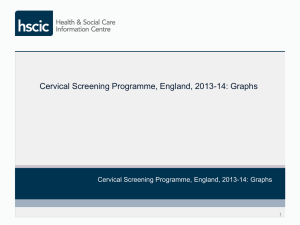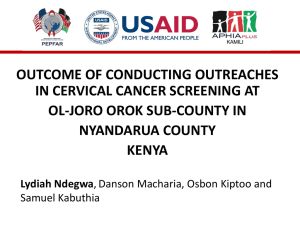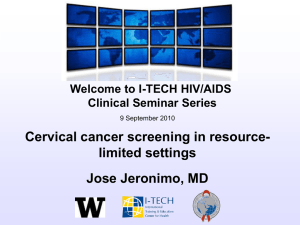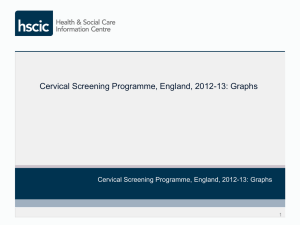Full Text (Submitted Manuscript , 124kb)
advertisement
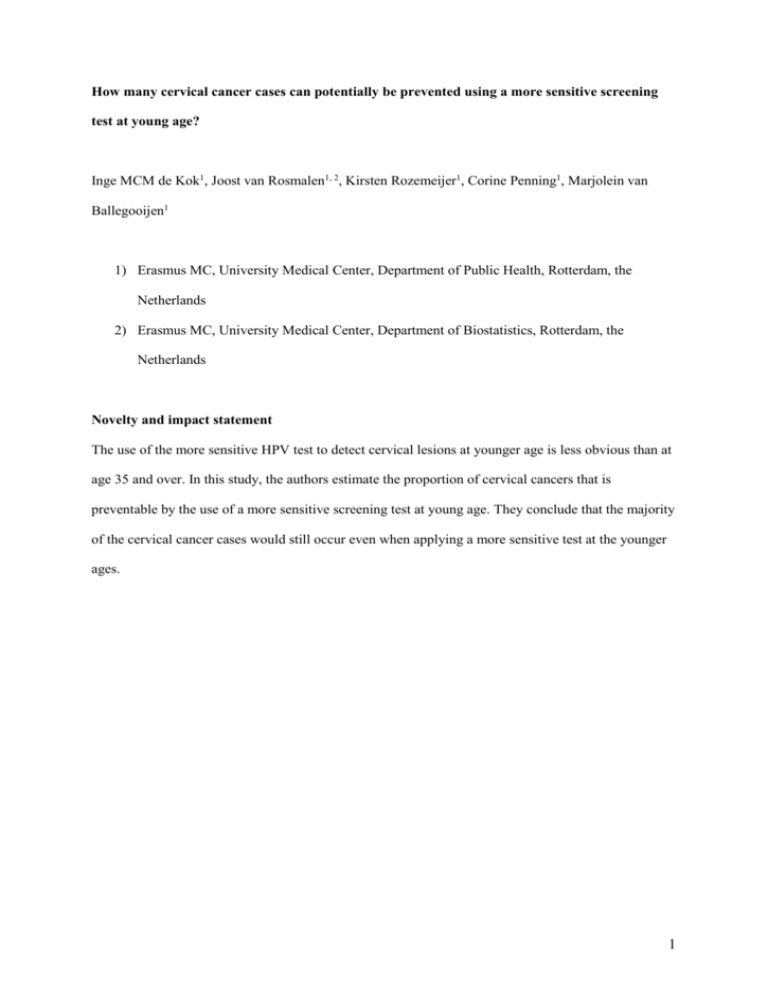
How many cervical cancer cases can potentially be prevented using a more sensitive screening test at young age? Inge MCM de Kok1, Joost van Rosmalen1, 2, Kirsten Rozemeijer1, Corine Penning1, Marjolein van Ballegooijen1 1) Erasmus MC, University Medical Center, Department of Public Health, Rotterdam, the Netherlands 2) Erasmus MC, University Medical Center, Department of Biostatistics, Rotterdam, the Netherlands Novelty and impact statement The use of the more sensitive HPV test to detect cervical lesions at younger age is less obvious than at age 35 and over. In this study, the authors estimate the proportion of cervical cancers that is preventable by the use of a more sensitive screening test at young age. They conclude that the majority of the cervical cancer cases would still occur even when applying a more sensitive test at the younger ages. 1 Abstract (max. 250 words) The Human Papilloma Virus (HPV) DNA test has higher sensitivity than cytology for cervical cancer screening. Therefore, cervical cancer cases that are missed by cytology could potentially be identified if we use primary HPV testing. Studies showed that HPV screening is the preferred primary test at age 35 and over. Given the high prevalence of harmless HPV infections, the use of HPV testing at younger age is less obvious. The number of cancers in young age is often mentioned to indicate the possible benefits of a more sensitive test. We actually estimated the proportion of those cases that is potentially preventable in the Netherlands by the use of a more sensitive screen-test at the first screening age 30, given that the more sensitive test is used at age 35 and over. We analysed the screening history of women diagnosed with cervical cancer in the period 2004-March 2009, using data from the Dutch national pathology registry. Only 15-30% (2 to 4 cases per 100,000 women) of the cases was preceded by negative cytology under age 35 and therefore could have been prevented by a more sensitive test at age 30. The lower the screening coverage and the shorter the screening interval in those screened at young age, the smaller the gain of a more sensitive test. So, as long as the current screening pattern is not changed, the majority of the cervical cancer cases at young age would still occur even when applying a more sensitive test at the younger ages. 2 Background Mass screening for cervical cancer has been operational for women from age 30 years onwards in the Netherlands since 1996.1 Nevertheless, still approximately 700 women are diagnosed with cervical cancer annually in the Netherlands, of which 160 cases in the age group 30-39.2 Some of these cases were diagnosed based on symptoms while unscreened or were detected by their first screening moment 3. In these women, lack of screening test sensitivity did not play a role. However, some cases had screening but tested negative,3 which might well be due to lack of sensitivity of, in the current situation, cytological screening. Meta-analyses and pooled analyses have established that Human Papilloma Virus (HPV) DNA tests have higher sensitivity than cytology for detecting high grade, clinically relevant, cervical intraepithelial lesions (high grade CIN).4-5 Therefore, cervical cancer cases that are missed by cytology could have been identified if we had used primary HPV DNA testing as the primary screening test. Several studies showed that HPV screening is the preferred primary test at age 35 and over.6-12 HPV testing is less specific than cytology because it can detect harmless HPV infections. Since these are considerably more prevalent in young women, the net benefits of using HPV testing under age 35 is less obvious.13-14 Frequent screening at a young age detects many transient infections, cytological and histological abnormalities and every screening round adds to unnecessary triage, overdiagnosis and overtreatment as a consequence. On the other hand, the number of life years gained per extra death prevented in young women is high, and the prevention of cervical cancer incidence and mortality at young age is valuable. The goal of this study is to estimate how many cases are potentially preventable in the Netherlands by the use of a more sensitive screen-test before the age of 35, assuming that this more sensitive test is (already) offered after the age of 35 years. To this end, we analyzed the screening history of women with cervical cancer diagnosed in the period January 2004-March 2009, using data from the Dutch national pathology file that includes cervical cytology and histological results.15 3 Methods To analyse the screening history of women diagnosed with cervical cancer in the period January 2004 - March 2009, we used data from the Dutch nationwide network and registry of histo- and cytopathology (PALGA). The registration began in the late 1970s and achieved practically complete coverage of pathology laboratories in 1990. The network registers cervical smears and biopsies taken in all settings: primary smears within the screening programme, opportunistic screening, smears and biopsies taken because of medical complaints, and secondary (diagnostic and follow- up) tests, regardless of whether they are taken or read by public or private healthcare providers and laboratories. In the PALGA network, women are identified through their birth date and the first four letters of their (maiden) family name. This identification code enabled linkage of multiple tests belonging to the same woman, allowing us to follow the individual screening and disease histories. The problem of false identity matches was avoided by excluding women with 0.5% most common maiden names in the analyses.16 The implicit assumption used here is that the screening histories and the commonness of surnames are not associated. Registered screening histories were organized into screening episodes. An episode starts with a primary test (a smear or a biopsy) followed by secondary tests in case this test was abnormal (at least borderline dyskaryosis) or of inadequate quality. Follow-up or secondary tests were defined as the tests made within 4 years following the primary test, unless the follow-up of this primary smear had already been completed according to the guidelines (e.g., with two consecutive negative smears after a borderline dyskaryotic smear, or three consecutive negative smears after histologically confirmed cervical intraepithelial neoplasia (CIN)). All other tests were regarded primary tests. Analyses Analyses were performed for different age groups, i.e. 30-35 years, 30-40 years, and ≥30 years. The definition of age is the age of a woman at the end of the calendar year. This is because in the Netherlands women are invited to participate in screening during the year they become 30, 35, 40, 45, 50, 55 or 60 years. Therefore, some women are still 29, 34, etc, at the time they are being screened. Age groups were based on the fact that women below the age of 30 are not invited to participate into 4 screening. In general, since women are screened with an interval of 5 years, the age group 30-35 years will show the interval cases that are missed at the first screening round. The age group 30-40 years will show the interval cases and cases picked up at the second screening round, that are missed at the first screening round. We wanted to estimate how many cases were possibly the result of a failure of cytological screening (i.e. a normal cytological result while a cancer (precursor) is present) performed before the age of 35, and could possibly have been prevented if a more sensitive test had been used, by analysing the screening history of women with cervical cancer. To this end, we first identified cervical cancer cases diagnosed at ages 30-35 years, 30-40 years, and ≥30 years by selecting all PALGA records that included pathology codes for cervical cancer between 2004 and March 2009. For these women, we reviewed the free text of all histology reports in PALGA. Age of diagnosis was defined as the age at the date of the first registered pathology code for cervical cancer in PALGA. Of all cervical cancer cases diagnosed in women aged 30-35 years, we first excluded those diagnosed at the first episode in a woman’s lifetime (Fig. 1). If the cancer was diagnosed at the first episode, it could not have been found earlier using a more sensitive test. Second, we analysed whether the primary cytology test of the episode prior to the episode in which the cancer was diagnosed, was performed before the age of 35 years (Fig. 1). If the previous episode started after the age of 35 years, we assumed that these cases were not the result of a false negative cytological test performed before the age of 35 years and therefore could not potentially be diagnosed earlier by HPV screening before the age of 35 years. Third, of the cases diagnosed in the second or later episode in a woman’s lifetime and with a previous episode starting before the age of 35 years, we excluded those cases with an abnormal cytological result before the age of 35 (Fig. 1). For these cases, the cancer (precursor lesion) was not missed by the primary cytological test, but by the follow up, like false-negative follow-up or no (complete) follow-up. If we assume a similar triage test in case of primary HPV testing and primary cytological testing, these cases would also not have been diagnosed by follow up after a positive HPV test. If there were only negative cytological results before the age of 35 years, these cases (or their precursors) were possibly missed due to a false-negative test. These cases represent the cases that are potentially preventable by the more sensitive HPV test before age 35. 5 To explore the probability that the lesion was missed by the cytological test, we analysed what the interval was between the date of first test of the episode in which the cancer was diagnosed and the date of the primary test of the previous episode. The shorter the interval, the more likely the lesion was already present at the time of screening. In other words, if the interval was short after a normal cytological result, the chance that the (pre-)cancer had been missed by the preceding cytological test would be larger than if the interval was longer. Furthermore, we did the same subsequent analyses for women diagnosed with cervical cancer aged 30-40 years, and for women aged ≥30 years. We calculated the percentage of cases that could potentially be prevented per age group, by dividing the number of cervical cancer cases that could possibly be prevented per age group and interval, by the number of cervical cancer cases diagnosed per age group. We calculated 95% binomial proportion confidence intervals using an exact method. We estimated the number of cervical cancer cases that could potentially be prevented per year and age group in the Netherlands using a more sensitive test before the age of 35 years, by multiplying the number of cancers diagnosed in 2011 in the Netherlands Cancer Registry2 with the calculated percentage of cases that could be prevented. We calculated the crude rate of the number of cancer cases per 100,000 women using the Dutch female population in the specific age groups in the period 2011-2012.17 Results After the exclusion of the 0.5% most common surnames, 226 diagnosed cervical cancer cases were still registered in PALGA in the period January 2004-March 2009 in women aged 30-35 years, 583 in women aged 30-40 years, and 2426 in women aged ≥30 years (Fig.1, Table 1). Of the women aged 3035 years, 67% had never been screened before the cancer was diagnosed. Of the remaining 33% (75 cases), 74 cases (99%) had the last cytological test before the episode in which the cancer was diagnosed, before the age of 35 years. In 63 of these 74 cases (85%), no cytological abnormality was found at that last screen test. In 83% (N=52) of these cases, the interval between the first test of the episode in which cervical cancer was diagnosed and the previous primary smear was less than 10 years, in 63% (N=40) it was less than 5 years (Table 2). 6 In women aged 30-40 years, 583 cervical cancer cases were diagnosed (Table 1). Of these women, 49% were never screened before the cancer was diagnosed. Of the remaining 51% (297 cases), 207 cases (70%) had the last cytological test before the episode in which the cancer was diagnosed, before the age of 35 years. In 160 of these 207 cases (77%), no cytological abnormality was found at the last screen test performed before the cancer was diagnosed. In 82% (N=131) of these cases, the interval between the first test of the episode in which cervical cancer was diagnosed and the previous primary smear was less than 10 years, in 51% (N=82) it was less than 5 years (Table 2). In women aged ≥30 years, 2426 cervical cancer cases were diagnosed (Table 1). Of these women, 43% were never screened before the cancer was diagnosed. Of the remaining 57% (1377 cases), 318 cases (23%) had the last cytological test before the episode in which the cancer was diagnosed, before the age of 35 years. In 219 of these 318 cases (69%), no cytological abnormality was found at the last screen test performed before the cancer was diagnosed. In 65% (N=142) of these cases, the interval between the first test of the episode in which cervical cancer was diagnosed and the previous primary smear was less than 10 years, in 37% (N=82) it was less than 5 years (Table 2). In Table 3 and Figure 2 we show how many cases are potentially preventable per year and age group, by the use of a more sensitive screening test before the age of 35 years. If we assume that the lesion was already present at the screening moment less than 5 years before the cancer was diagnosed, 2.6 cancer cases per 100,000 women (18%, 95% CI 12.7-22.7) per year are missed and potentially preventable in age group 30-35 years. For the age groups 30-40 and ≥30 years, 2.2 (14%) and 0.4 (3%) cases per 100,000 women are potentially preventable per year. If we assume that the lesion was already present at the screening moment less than 10 years before the cancer was diagnosed, 3.3 cases per 100,000 women (23%, 95% CI 17.5-28.5) are annually potentially preventable in age group 30-35 years, 3.4 (22%, 95% CI 19.1-25.9) in age group 30-40 years and 0.8 (6%, 95% CI 4.9-6.8) in age group ≥30 years. For a screening moment ≤15 years before the cancer was diagnosed these figures are 3.5 (27%, 95% CI 21.2-32.8), 4.1 (26%, 95% CI 22.3-29.5) and 1.0 (8%, 95% CI 6.5-8.6) cases per 100,000 women per year, for age groups 30-35, 30-40 and ≥30 years, respectively. If all screening moments before the cancer was diagnosed are considered, regardless of the interval of the previous test and the cancer diagnoses, these figures are 4.1 (28%, 95% CI 22.0-33.7), 4.2 (27%, 95% CI 23.8- 7 31.1) and 1.2 (9%, 95% CI 7.9-10.2) cases per 100,00 women per year for age groups 30-35, 30-40 and ≥30 years, respectively. Discussion We showed that only 9% of the women aged ≥30 years who were diagnosed with cervical cancer in recent years could potentially have benefited from a more sensitive test (than the Pap smear) also at age 30 instead of having this more sensitive test only from age 35 onwards. The other women with cervical cancer either did not attend cervical screening before the cancer diagnoses (43%), or attended screening only after age 35 (44%), or already had a positive test before age 35 using the less sensitive Pap smear (4%). Women in the latter categories would not have benefited from having had a more sensitive test offered instead of a Pap smear. Depending on the age at diagnosis and the interval since that last negative Pap smear considered, the percentage of cases that could potentially have been avoided by offering a more sensitive test varies from 3% in women aged ≥30 years with an interval of less than 5 years, to 28% in all women aged 30-35 years. This shows the maximum possible benefit when performing HPV testing at all screening ages (including age 30) compared to only at the ages over 35 years. Furthermore, the achieved benefit must be balanced with the relatively high positivityrate of HPV testing at age 30 compared to the rate in older ages. There are two explanations for a normal cytological test result in the episode before cervical cancer is diagnosed: 1) there is no neoplasia present yet, 2) the lesion is present but missed by the test. The interval between the first manifestation of CIN 1 and the development of clinical cervical cancer is estimated to be on average 15 years.18-21 Therefore, explanation 2 becomes less probable when the normal test result took place more than 10 years before cervical cancer was diagnosed, and even less so in case of an interval of more than 15 years. For the tests performed less than 10 years before cancer diagnosis, and especially for the tests performed less than 5 years before diagnosis, however, explanation 2 seems most likely, meaning that a more sensitive test in principle could have detected the present lesions. We showed that, if we assume that the lesion was already present at the screening moment less than 10 years before the cancer was diagnosed, 3.3 (23%) cases per 100,000 women have been annually missed and are potentially preventable in age group 30-35 years, 3.4 (22%) in age group 8 30-40 years and 0.8 (6%) in age group ≥30 years. Note that these figures are a maximum and one would have to assume 100% sensitivity to prevent them all by the alternative test. Although the HPV test is more sensitive than the Pap test, it is not 100% sensitive.4 The presented proportions of cervical cancer cases that can be prevented by a more sensitive test at age 30 are representative for the Netherlands. The question is to what extent they are applicable for other countries. This depends on several factors, such as the coverage of the screening programme at young age, the frequency of screening and the sensitivity of the cytological test in the specific situation. For example in the United States, the percentage of young women that undergo screening is higher than in the Netherlands,22 therefore the probability that women had a previous primary smear before the cancer was diagnosed is higher. This would results in a higher number of potentially preventable cases. On the other hand, since the frequency of screening is also higher in the United States compared to the Netherlands,22 the probability that a lesion was missed in a pre-invasive stage is lower. This would result in a lower number of potentially preventable cases. Test-positive rates are up to three times higher with HPV DNA screening than with cytology.23 HPV DNA screening consequently also causes more false-positive tests, i.e. positive screening tests without underlying (clinically relevant) CIN or cervical cancer. These women will have unnecessary followup, such as repeat testing or a referral for colposcopy, which have important psychosocial consequences.24 Moreover, most women with high-grade CIN are of reproductive age, which will be picked up by HPV DNA screening applied <35 years of age. Treatment of CIN is associated with a small but real increase in risk of pregnancy-related morbidity, such as premature delivery (<37 weeks), low birthweight (<2500 g) and preterm prelabour rupture of membranes.25-27 These disadvantages must be weighed against the advantages of the extra cervical cancer cases that are potentially preventable by using a more sensitive screen test. In the Netherlands, all smears and histologically diagnosed cervical cancer cases are in principle registered in PALGA. However, the total number of women aged ≥30 years with an incident cervical cancer in 2004-2008 in PALGA differs from the number published by the Cancer Registry (+14%). Nevertheless, PALGA is the only comprehensive registry in the Netherlands that links the cancer cases with their screening history. 9 In the future, studying interval cancers by stage would be useful, to get more insight into the cause of the occurrence of the cancer after a negative screening test. For example, low stage tumours are more likely newly developed tumours (not missed by the screen test). Unfortunately, tumour stage has not yet been included in the PALGA registry. To determine the total effect of applying a more sensitive screen test at younger ages, next to the effect on the cervical cancer incidence, the effect on cervical cancer mortality needs to be estimated. Currently, cervical cancer mortality is not included in the PALGA registry. In the future, we intend to link cervical cancer mortality to screening history to improve the evaluation of different cervical cancer screening methods. We showed that 43% of the cervical cancer patients did not attend screening before they were diagnosed. Some of these cases could possibly have been prevented by offering an HPV-selftest to non-attending women. It has been shown that offering an HPV-selftest to non-responding women increases the screening participation rate with approximately 6%.28 Furthermore, 25% of the women who never had been screened before, did attend the HPV-selftest.29 HPV vaccination was recently introduced in the Dutch National Immunisation Programme (NIP). In 2009, a catch-up programme was started for girls born in 1993 to 1996. Vaccination of the first NIP cohort (i.e. girls born between January 1, 1997 and August 31, 1997) started in April 2010. Since all women born after 1992 have been or will be invited for HPV vaccination, vaccinated women will reach the initial screening age (i.e. 30 years) in 2023. Since it is expected that the cervical cancer incidence will decrease as a result of the vaccination, in the future, we need to reconsider the costeffectiveness of screening, and especially HPV screening. Determining the effectiveness of screening programmes for vaccinated women will require a separate analysis that can be performed when more is known about the long-term effectiveness of HPV vaccination. In conclusion we showed that the total incidence of cervical cancer at young screening age is not a good indicator for the potential gain when applying a more sensitive test at young age. For the Dutch situation, only 15% to 30% of all cases diagnosed in age group 30-40 years were preceded by a negative cytology based screen test and could therefore potentially have been prevented by a more sensitive screen test at age 30, e.g. an HPV test. As long as the current screening pattern is not 10 changed, the majority of the cervical cancer cases at young age, would still occur even when applying a more sensitive screen-test at the younger screening ages. The lower the screening coverage and the shorter the screening interval in those screened at young age, the lower the preventable proportion. Funding This study was funded by the Dutch National Institute for Public Health and the Environment (RIVM, grant No 3022/07 DG MS/CvB/NvN). The RIVM had no role in the design of the study; the collection, analysis, and interpretation of the data; the writing of the report; and the decision to submit the manuscript for publication. The researchers worked independently of the funders. 11 References 1. Rebolj M, van Ballegooijen M, Berkers LM, Habbema D. Monitoring a national cancer prevention program: successful changes in cervical cancer screening in the Netherlands. Int J Cancer 2007;120(4):806-12. 2. Netherlands Cancer Registry (NCR). www.cijfersoverkanker.nl, Incidence figures cervical cancer, 2011. 3. Bos AB, Rebolj M, Habbema JD, van Ballegooijen M. Nonattendance is still the main limitation for the effectiveness of screening for cervical cancer in the Netherlands. Int J Cancer 2006;119(10):2372-5. 4. Arbyn M, Sasieni P, Meijer CJ, Clavel C, Koliopoulos G, Dillner J. Chapter 9: Clinical applications of HPV testing: a summary of meta-analyses. Vaccine 2006;24 Suppl 3:S3/78-89. 5. Cuzick J, Clavel C, Petry KU, Meijer CJ, Hoyer H, Ratnam S, et al. Overview of the European and North American studies on HPV testing in primary cervical cancer screening. Int J Cancer 2006;119(5):1095-101. 6. Berkhof J, Coupe VM, Bogaards JA, van Kemenade FJ, Helmerhorst TJ, Snijders PJ, et al. The health and economic effects of HPV DNA screening in The Netherlands. Int J Cancer 2010;127(9):2147-58. 7. de Kok IM, van Rosmalen J, Dillner J, Arbyn M, Sasieni P, Iftner T, et al. Primary screening for human papillomavirus compared with cytology screening for cervical cancer in European settings: cost effectiveness analysis based on a Dutch microsimulation model. Bmj 2012;344:e670. 8. Goldie SJ, Kim JJ, Wright TC. Cost-effectiveness of human papillomavirus DNA testing for cervical cancer screening in women aged 30 years or more. Obstet Gynecol 2004;103(4):61931. 9. Kim JJ, Wright TC, Goldie SJ. Cost-effectiveness of human papillomavirus DNA testing in the United Kingdom, The Netherlands, France, and Italy. J Natl Cancer Inst 2005;97(12):888-95. 10. Mittendorf T, Petry KU, Iftner T, Greiner W, von der Schulenburg JM. Economic evaluation of human papillomavirus screening in Germany. Eur J Health Econ 2003;4(3):209-15. 12 11. Sherlaw-Johnson C, Philips Z. An evaluation of liquid-based cytology and human papillomavirus testing within the UK cervical cancer screening programme. Br J Cancer 2004;91(1):84-91. 12. van Rosmalen J, de Kok IM, van Ballegooijen M. Cost-effectiveness of cervical cancer screening: cytology versus human papillomavirus DNA testing. Bjog 2012;119(6):699-709. 13. Goldhaber-Fiebert JD, Stout NK, Salomon JA, Kuntz KM, Goldie SJ. Cost-effectiveness of cervical cancer screening with human papillomavirus DNA testing and HPV-16,18 vaccination. J Natl Cancer Inst 2008;100(5):308-20. 14. Wright TC, Jr., Schiffman M, Solomon D, Cox JT, Garcia F, Goldie S, et al. Interim guidance for the use of human papillomavirus DNA testing as an adjunct to cervical cytology for screening. Obstet Gynecol 2004;103(2):304-9. 15. Casparie M, Tiebosch AT, Burger G, Blauwgeers H, van de Pol A, van Krieken JH, et al. Pathology databanking and biobanking in The Netherlands, a central role for PALGA, the nationwide histopathology and cytopathology data network and archive. Cell Oncol 2007;29(1):19-24. 16. van den Akker-van Marle ME, van Ballegooijen M, Habbema JD. Low risk of cervical cancer during a long period after negative screening in the Netherlands. Br J Cancer 2003;88(7):1054-7. 17. CBS (netherlands Central Bureau of Statistics). Population by sex and age, 2004-2008. Voorburg. 18. Gustafsson L, Adami HO. Natural history of cervical neoplasia: consistent results obtained by an identification technique. Br J Cancer 1989;60(1):132-41. 19. van Oortmarssen GJ, Habbema JD. Epidemiological evidence for age-dependent regression of preinvasive cervical cancer. Br J Cancer 1991;64(3):559-65. 20. van Oortmarssen GJ, Habbema JD. Duration of preclinical cervical cancer and reduction in incidence of invasive cancer following negative pap smears. Int J Epidemiol 1995;24(2):3007. 21. van Oortmarssen GJ, Habbema JD, van Ballegooijen M. Predicting mortality from cervical cancer after negative smear test results. BMJ 1992;305(6851):449-51. 13 22. Habbema D, De Kok IM, Brown ML. Cervical cancer screening in the United States and the Netherlands: a tale of two countries. Milbank Q 2012;90(1):5-37. 23. Lynge E, Rebolj M. Primary HPV screening for cervical cancer prevention: results from European trials. Nat Rev Clin Oncol 2009;6(12):699-706. 24. Korfage IJ, van Ballegooijen M, Huveneers H, Essink-Bot ML. Anxiety and borderline PAP smear results. Eur J Cancer 2010;46(1):134-41. 25. Arbyn M, Kyrgiou M, Simoens C, Raifu AO, Koliopoulos G, Martin-Hirsch P, et al. Perinatal mortality and other severe adverse pregnancy outcomes associated with treatment of cervical intraepithelial neoplasia: meta-analysis. BMJ 2008;337:a1284. 26. Kyrgiou M, Koliopoulos G, Martin-Hirsch P, Arbyn M, Prendiville W, Paraskevaidis E. Obstetric outcomes after conservative treatment for intraepithelial or early invasive cervical lesions: systematic review and meta-analysis. Lancet 2006;367(9509):489-98. 27. van de Vijver A, Poppe W, Verguts J, Arbyn M. Pregnancy outcome after cervical conisation: a retrospective cohort study in the Leuven University Hospital. BJOG 2010;117(3):268-73. 28. Gok M, Heideman DA, van Kemenade FJ, Berkhof J, Rozendaal L, Spruyt JW, et al. HPV testing on self collected cervicovaginal lavage specimens as screening method for women who do not attend cervical screening: cohort study. BMJ 2010;340:c1040. 29. Gok M, Heideman DA, van Kemenade FJ, de Vries AL, Berkhof J, Rozendaal L, et al. Offering self-sampling for human papillomavirus testing to non-attendees of the cervical screening programme: Characteristics of the responders. Eur J Cancer 2012;48(12):1799-808. 14 Figure 1. Analyses of screen history of women diagnosed with cervical cancer at age 30-35 years, in the period January 2004 - March 2009 (N=number of cases, Q=question). ‘Excluded’ means that these cases could not have been prevented by using a more sensitive test at age 30. N = 226 100% Yes No Excluded N = 151 67% N = 75 33% Q2. Was the last primary smear performed at age <35 years? Yes No Excluded N=1 1% N = 74 99% Yes N = 63 85% Q1. Was there a previous episode with a primary smear as first test? No Excluded N = 11 15% Q3. Where all primary cytology tests < 35 years normal? 15 Table 1. Analyses of screen history of women diagnosed with cervical cancer in the period January 2004 - March 2009, by age at cancer diagnosis (following the decision tree as presented in Fig 1 for age group 30-35 years) Age of cervical cancer diagnoses Total N Cases with a previous episode with primary smear N (% of total) Of (a), the cases of which the last Of (b), the cases primary smear with only normal was performed smear results <35 <35 years years N (% of total) N (% of total) (a) (b) (c) 30-35 years 226 75 (33) 74 (33) 63 (28) 30-40 years 583 297 (51) 207 (36) 160 (27) ≥30 years 2426 1377 (57) 318 (13) 219 (9) Table 2. Number of cervical cancer cases of which all previous cytology was under age 35 and negative in the period January 2004 - March 2009, by age at cancer diagnosis and the interval between the date of first test of the episode in which the cancer was diagnosed and the date of the primary test of the last previous episode. Age of cervical cancer diagnoses ≤5 years N(%) ≤10 years N(%) ≤15 years N(%) Total N(%)* 30-35 years 40 (63) 52 (83) 61 (97) 63 (100) 30-40 years 82 (51) 131 (82) 151 (94) 160 (100) ≥30 years 82 (37) 142 (65) 184 (84) 219 (100) * Column (c) in Table 1 16 Table 3. Nationwide annual number of cancer cases per 100,000 women (Source: Netherlands Cancer Registry) of which the last previous cytology was under age 35 and negative, and that therefore could potentially have been prevented with a more sensitive test at age 30, by age at cancer diagnosis and interval since that last negative smear Age at cancer diagnosis Total incidence in 2011 Preventable incidence in 2011 Interval ≤5 years Interval ≤10 years Interval ≤15 years N per 100,000 women % cases (95% CI) N cases N cases per 100,000 women % cases (95% CI) N cases N cases per 100,000 women % cases (95% CI) 30-35 years 73 14.5 18% (12.7-22.7) 13 2.6 23% (17.5-28.5) 17 3.3 30-40 years 164 15.6 14% (11.2-16.9) 23 2.2 22% (19.1-25.9) 36 ≥30 years 711 12.9 3% (2.7-4.1) 21 0.4 6% (4.9-6.8) 43 All intervals N cases N cases per 100,000 women % cases (95% CI) N cases N cases per 100,000 women 27% (21.2-32.8) 20 3.9 28% (22.0-33.7) 20 4.1 3.4 26% (22.3-29.5) 43 4.1 27% (23.8-31.1) 44 4.2 0.8 8% (6.5-8.6) 57 1.0 9% (7.9-10.2) 64 1.2 17 Figure 2. Maximum proportion of cervical cancer cases of which the last previous cytology was under age 35 and negative, and that therefore could potentially have been prevented with a more sensitive test at age 30, by age group and interval since that last negative smear (Table 3) 800 N cancers diagnosed per year in the Netherlands Interval with previous smear <10 years 700 Interval with previous smear ≥10 years 9% (95% CI 7,9-10,2) Not preventable under current screening schedule 600 500 400 300 200 27% (95% CI 23,8-31,1) 28% (95% CI 22,0-33,7) 100 0 30-35 years 30-40 years ≥30 years Age of diagnoses 18

